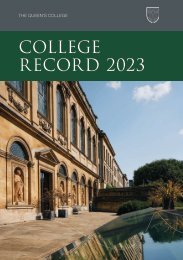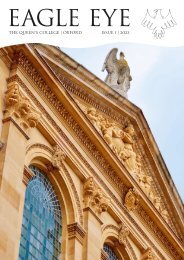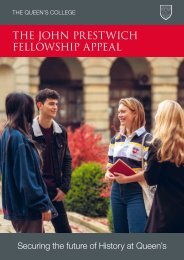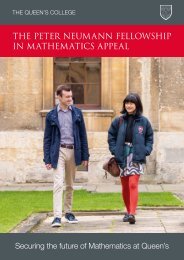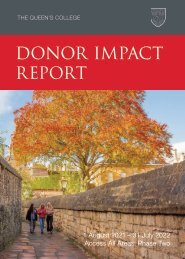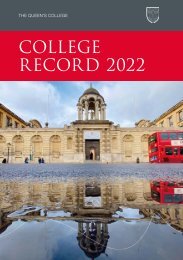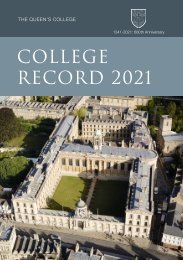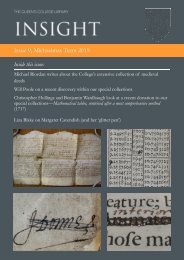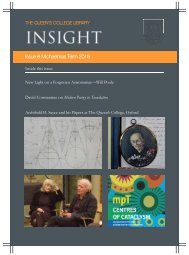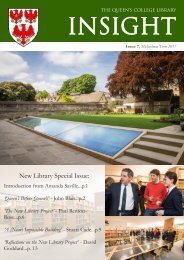The Queen's College Record 2020
You also want an ePaper? Increase the reach of your titles
YUMPU automatically turns print PDFs into web optimized ePapers that Google loves.
church, journalism, films and tourism, as well as paths with a more direct chemical<br />
connection. What united them was an affection for Morrin, his sense of humour and<br />
his zest for life.<br />
Obituaries<br />
Before coming to Queen’s, Morrin was an undergraduate and graduate at Magdalen,<br />
gaining a First in Natural Sciences (Chemistry) in 1946, then a BSc by research in<br />
1947 and DPhil in 1948. He was a Medical Research Council fellow at the University<br />
of Nottingham from 1948-49 and held a post-doctoral fellowship at the University of<br />
Chicago from 1949-1950.<br />
Morrin had very broad research interests. Although based in the Biochemstry<br />
Department, his work, by and large, was firmly rooted in organic chemistry. <strong>The</strong> main<br />
body of his work was investigating the chemistry of a highly reactive substance,<br />
dimethyl acetylene dicarboxylate, known affectionately as ‘the ester’ with a vast<br />
miscellany of heterocyclic compounds, starting with pyridine. His early work sought<br />
to identify the structure of the products first seen by the great German chemist, Diels.<br />
Morrin was pioneering in his use of then new spectroscopic methods particularly NMR<br />
to solve the structures. It was this work that led to the H A Iddles award for 1966/67,<br />
from the University of New Hampshire. He held the distinction of being the first<br />
recipient from outside the USA. In all he published over 220 scientific papers, of which<br />
over a third were related to addition reaction of heterocylic compounds with ‘the ester’.<br />
<strong>The</strong> reaction of ‘the ester’ with heterocycles often produced previously unknown<br />
ring structures, which were of great interest to the pharmaceutical industry as novel<br />
drug templates. He consulted for several pharmaceutical companies including Pfizer,<br />
where one of his former pupils invented the block buster cardiovascular substance<br />
amlodipine/Norvasc®. He was also named as an inventor on several patents.<br />
Morrin wrote two significant books. <strong>The</strong> first was a monograph on acridines, a class<br />
of heterocycles with a wide range of biological properties, from a bitter taste to use<br />
as dyes and the basis of various antimalarial drugs (1st Edn 1956, 2nd Edn 1973).<br />
<strong>The</strong> second was his text book, An Introduction to the Chemistry of Heterocyclic<br />
Compounds, (1st Edn 1960, 2nd Edn 1967, 3rd Edn, 1976; also Japanese and<br />
Spanish editions) which systematically described this rather disparate group of<br />
substances in a clear, concise and palatable form.<br />
This latter book was dedicated ‘To My BT and 3 LT’s’ - a reference to his wife, Greti,<br />
and his three children, Corina, Marita and Michael. Morrin’s family was extremely<br />
important to him and he was careful to strike a balance between work and home<br />
life. He was devoted to Greti, whom he had met during his post-doctoral studies in<br />
Chicago and married in 1953. <strong>The</strong>y shared a passion for dancing, which led to the<br />
establishment of the Oxford University Ballroom Dancing Club (now OU Dancesport) in<br />
1968. He was also senior member of the OU Company of Archers.<br />
From an early age, Morrin was an active mountaineer of some distinction. He was<br />
a member of the OU Expedition to Tehri-Garhwal in the Himalayas in the summer<br />
116 <strong>The</strong> Queen’s <strong>College</strong> | <strong>College</strong> <strong>Record</strong> <strong>2020</strong>








